Books
Books

L’Architecte et la Femme au foyer
Dans son atelier, qui est aussi son salon, Frances Stark se demande si elle ne serait pas devenue une Femme au foyer. Elle observe avec amusement et lassitude les artistes hommes qu’elle associe à la figure des Architectes parce qu’ils séparent production artistique et activité ménagère, art et décoration et qu’ils ont la chance de pouvoir quitter l’espace domestique pour aller créer ailleurs.
Frances Stark réfléchit à son expérience quotidienne, la mêlant à des réflexions sur des habitations construites par R.M. Schindler et Jorge Pardo, l’essai Critique comme artiste d’Oscar Wilde, le livre Une chambre à soi de Virginia Woolf ainsi que des déclarations de Daniel Buren, d’Adolf Loos, d’Otto Weininger, ou encore de Ludwig Wittgenstein. Elle livre ainsi ses pensées, vives et sagaces, sur les espaces d’exposition, les maisons, les chambres à coucher, les coussins décoratifs, en prenant aussi en compte les couples hommes-femmes qui les utilisent, s’y rencontrent, s’y unissent et s’y séparent.

Un Moyen Âge émancipateur
Clovis Maillet, Thomas Golsenne
Une récente enquête menée dans les écoles d’art et de design francophones aboutit à un constat étonnant : beaucoup d’étudiante·s affirment que l’artisanat est l’avenir de l’art et que les sorcières détruiront le patriarcat. Iels s’approprient un imaginaire composite mêlant fantasy et moines copistes, herboristerie médiévale et communalisme. Dans le même temps, des slogans en latin sont tagués sur les murs par de jeunes révolutionnaires. Des remèdes au capitalisme pourraient-ils se trouver dans le monde qui précéda son avènement ? Pour sonder cet imaginaire politique et artistique construit sur un passé lointain, Clovis Maillet et Thomas Golsenne analysent des œuvres contemporaines, des sources médiévales et la pensée de Silvia Federici et William Morris qui, chacun·e à leur endroit, proposent une vision du Moyen Âge émancipatrice.
Maître de conférences en histoire de l’art et études visuelles à l’Université de Lille, ancien directeur de l’unité de recherche Bricologie à la Villa Arson à Nice, Thomas Golsenne a publié Carlo Crivelli et le matérialisme mystique du Quattrocento (2017).
Professeur·e d’histoire et théorie des arts dans les écoles d’art d’Angers et de Genève, Clovis Maillet est aussi artiste performeur·euse en duo avec Louise Hervé et médiéviste. Iel est l’auteur·ice du livre Les Genres fluides : de Jeanne d'Arc aux saintes trans (2020).

Un énoncé surpris par hasard
Lorsqu’Allen Ginsberg s’enregistre sur un magnétophone et capte fortuitement des émissions de radio, le souffle du vent et des conversations, des agents du FBI et de la CIA l’écoutent, à la recherche d’aveux involontaires. En considérant ces agents comme de sérieux théoriciens de la poésie, Lytle Shaw montre qu’ils s’inspirent des expérimentations d’avant-garde et transforment une technique libératrice en un outil répressif.
Lytle Shaw enseigne la littérature à l’Université de New York. Il a publié Frank O’Hara : The Poetics of Coterie en 2006 (University of Iowa Press) et Fieldworks : From Place to Site in Postwar Poetics en 2013 (University of Alabama). En 2021, est paru New Grounds for Dutch Landscape (OEI).
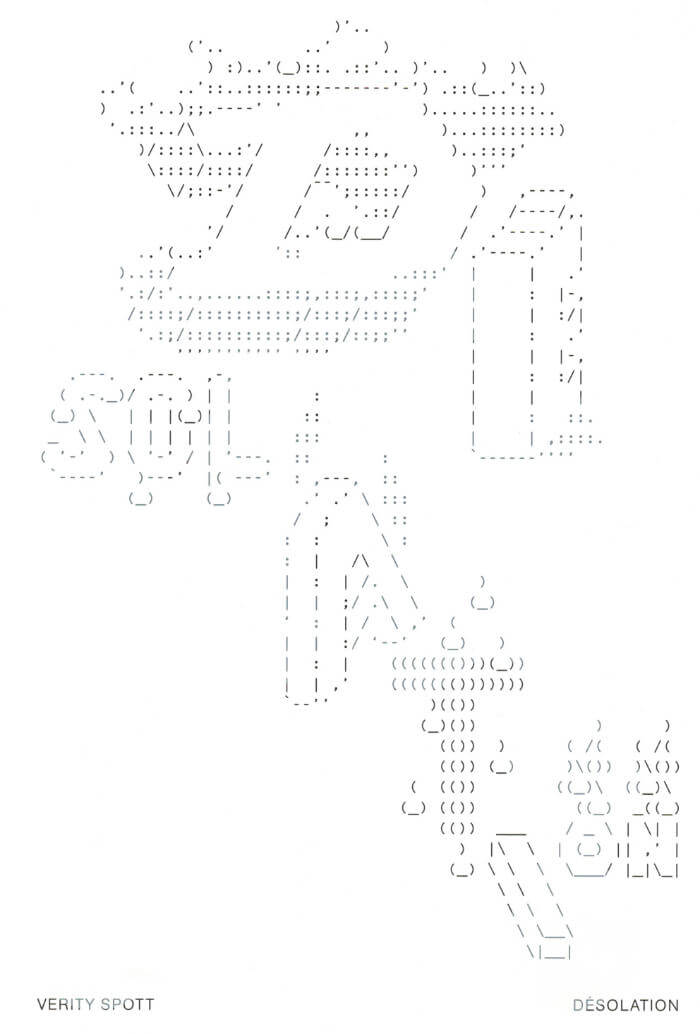
Désolation
Un hôpital où un corps est connecté à un dispositif médical. Un pré faussement idyllique sous lequel grouillent des câbles. Des rivages où des formes oscillent entre ensevelissement et immersion. Dans Désolation, Verity Spott propose une poésie fantasmagorique entre narration, prose et dialogues. L’expression des sentiments bouleverse les attributions des pronoms personnels et les structures syntaxiques. Des identités changeantes prennent à partie les politiques d’austérité et les voix d’extrême droite. Livre de deuil et d’amour qui frôle la satire, Désolation travaille une écriture hybride où s’entrelacent la poésie lyrique, des images tirées de blockbusters et le langage des démagogues pour contrer les moules qui tenteraient de dicter la forme de nos chagrins.
Verity Spott vit à Brighton, écrit de la poésie et fait des performances. Ses derniers livres comprennent Click Away Close Door Say (Contraband Books, 2017) et le recueil de ses Coronelles (Veer Books, 2021).

Le Discours des autres
Craig Owens (1950-1990) a bouleversé la théorie de l’art en une décennie d’intense travail. À la fin des années 1970, aux États-Unis, il s’engage dans l’aventure intellectuelle postmoderne, en quête d’alternatives à un discours moderniste cramponné aux problèmes formels. Owens se penche sur des pratiques artistiques conçues à la croisée des médiums, comme celles de Robert Smithson ou de Trisha Brown. Lecteur des philosophes poststructuralistes, il soutient que les oeuvres se composent de signes ouverts à l’interprétation. Owens place ainsi les spectateur·ices au premier plan, tout en apportant une inscription théorique inédite aux performances de Laurie Anderson et aux oeuvres postconceptuelles de Barbara Kruger, Cindy Sherman, Sherrie Levine ou Martha Rosler. Attentif au genre des artistes et inspiré par des réflexions sur le pouvoir du regard masculin, Owens écrit ensuite sur le féminisme et la domination. Ses essais prennent une tonalité sociale et politique. Ils touchent aussi à des questions ouvertes par les études postcoloniales. Autant de recherches interrompues par le sida, dont Owens meurt en 1990.
Ce recueil, établi, introduit et traduit par Gaëtan Thomas, permet de suivre les expérimentations d’une oeuvre portée par une réflexivité exceptionnelle.
Gaëtan Thomas est historien (médialab Sciences Po, Paris). Il a établi le recueil Pictures: S’approprier la photographie, New York 1979-2014 (Le Point du Jour, 2016) qui rassemble des textes de Douglas Crimp.
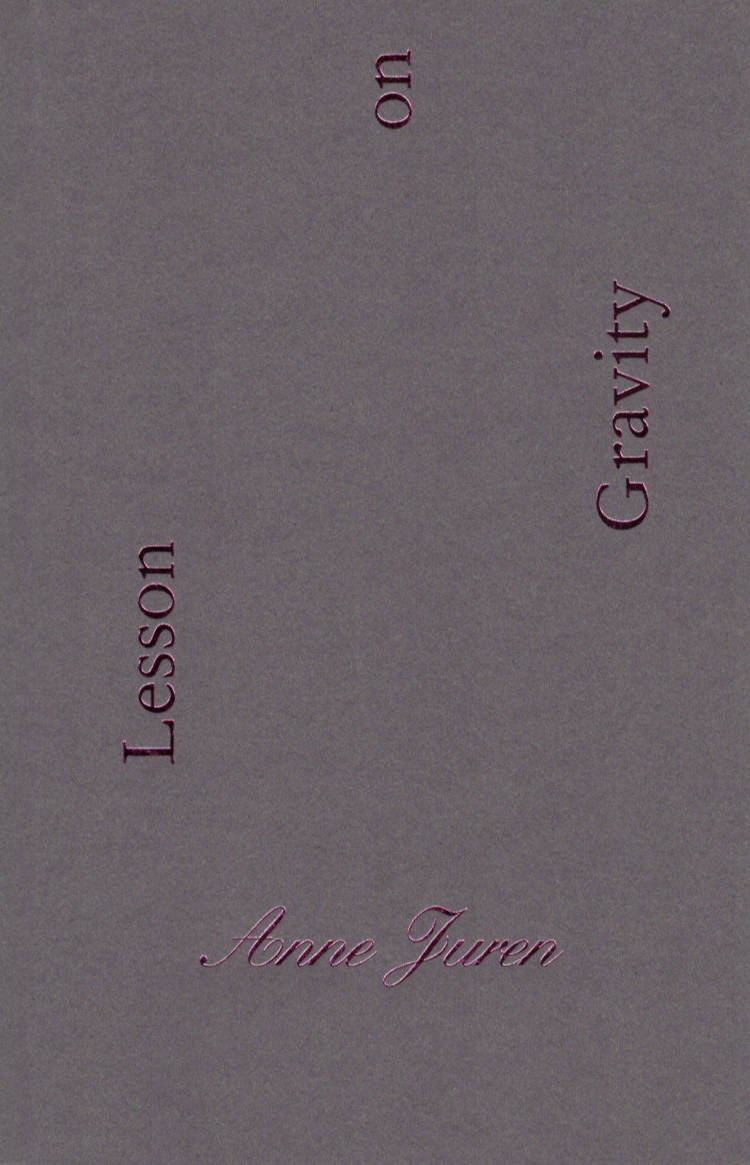
Lesson on Gravity
Lesson on Gravity is a slice of Anne Juren’s ongoing artistic research into ‘fantasmical anatomies’. ‘What happens when our sense of ground, orientation and support is lost? What are the risk and the promise of detaching ourselves from the pull of gravity?’ As this apocryphal Feldenkrais lesson embraces moments of intrusion and fragmentation, poetry and flights of fancy, it shows how language is alive, embodied and liquid. It also invites the reader to treat the book itself as a body, an unruly tongue sticking somewhere in its folds and creases
Anne Juren is a choreographer, dancer and Feldenkrais practitioner. In 2021 she finished her PhD at Stockholm University of the Arts with the project Studies on Fantasmical Anatomies.
Published by Varamo Press in the essay series Gestures
First edition, March 2023
Graphic design by Michaël Bussaer

Let Them Rot: Antigone's Parallax
A provocative, highly accessible journey to the heart of Sophocles' Antigone elucidating why it keeps resurfacing as a central text of Western thought and Western culture.
"Zupančič writes with rare lucidity and patience for exposition, helped along by a talent for turning peculiar phrases or seemingly senseless jokes into full-blown insights. Her ideas are fresh, as if they hailed from some open air beyond the clutter of current theoretical quarrels. This brilliant account of Antigone breaks new ground for philosophy, psychoanalysis, and political and feminist theory."—Joan Copjec, Brown University
There is probably no classical text that has inspired more interpretation, critical attention, and creative response than Sophocles' A ntigone. What is it about the figure of Antigone that keeps haunting us? To what kind of always contemporary contradiction does the need, the urge to reread and reimagine Antigone—in all kinds of contexts and languages—correspond?
The violence in Antigone is the opposite of "graphic" as we have come to know it in movies and in the media; rather, it is sharp and piercing, it goes straight to the bone. It is the violence of language, the violence of principles, the violence of desire, the violence of subjectivity. From this question of violence, the author turns to questions of funerary rites and of the relation of Antigone's singularizing claims to her universal appeal. What, Zupančič asks, does this particular (Oedipal) family's misfortune, of which Antigone chooses to be the guardian, share with the general condition of humanity? This forces us to confront the seemingly self-evident question: "What is incest?"
Let Them Rot is Alenka Zupančič's absorbing guided tour of the philosophical and psychoanalytic issues arising from the Theban trilogy. Her original and surprising account illuminates the play's ongoing relevance and invites a wide readership to become captivated by its themes.
Alenka Zupančič is Professor of Philosophy and Psychoanalysis at the European Graduate School and a researcher at the Institute of Philosophy at the Slovene Academy of Sciences and Arts. Her books include What IS Sex?, The Odd One In: On Comedy, and Ethics of the Real.
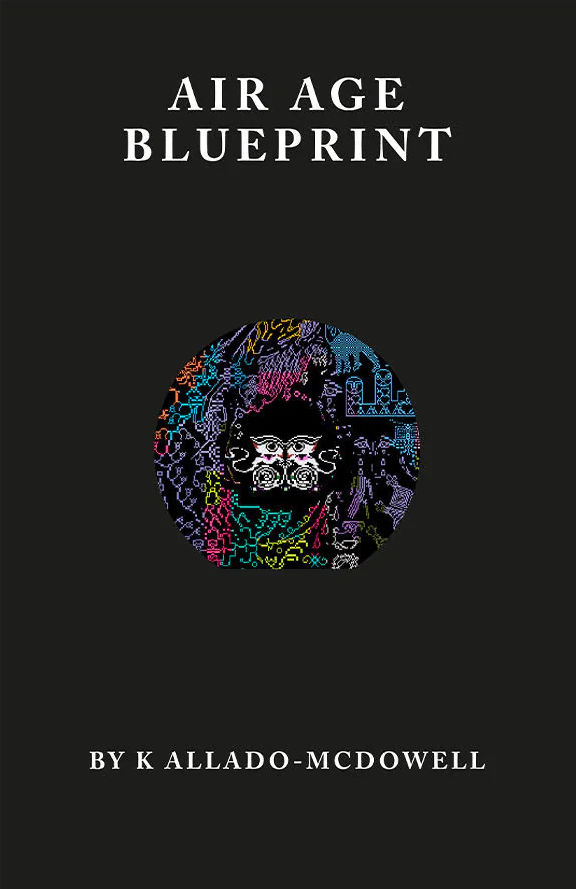
Air Age Blueprint
A young filmmaker’s life is disrupted by a fated encounter with a Peruvian healer. Called to twin paths of artistic creation and mystic truth-seeking, they set out on a transcontinental journey. In the Pacific Northwest they meet K, a double agent working between art and technology, who invites them to test a secret program called Shaman.AI. This human-machine experiment, rooted in magic, produces a key to rewriting reality – a manifesto describing how entangled human and non-human intelligence will remake our technologies, identities and deepest beliefs.
Allado-McDowell (along with their AI writing partner GPT-3) weave fiction, memoir, theory and travelogue into an animist cybernetics – an air age blueprint.
Cover art by Somnath Bhatt

Making Kin
Institute for Postnatural Studies
When we practice becoming with another’s experience, we practice empathy. When we embody collectiveness, we understand ourselves as a whole and therefore feel no separation. What would it be like to inhabit a body without limits or definition? Which words and meanings make us feel like “non-animals”? The literary genre of xeno fiction proposes an exercise of ethological research and imagination, placing our body inside another’s perspective. This publication convenes writers and non-writers that have experimented with animal embodiment to create literary works and visual interpretations that explore different ways to experience “otherness.” In this volume of the Making Kin series, we focus on non-human animals and hybrid bodies.
Authors: Zoë De Luca Legge, Esther Merinero, Eva Piay, John Kazior, Jorge de la Cruz, Marianne Hoffmeister Castro , Luca E. Lum, Anonymous, Paula Proaño Mesías, Laura Dominguez Valdivieso, Adèle Grégorie, Morgan Wood

We Know What Remains Unsaid
Ramaya Tegegne, Tiphanie Blanc
The second volume of a new series of publications by the collective Wages For Wages Against, acting for better work conditions in the visual arts and against all forms of discrimination.
We Know What Remains Unsaid presents research on the mechanisms of invisibilisation of precarious realities and activist knowledges. It investigates what our silences and the unsaid reveal. By giving a voice to several researchers, activists and collectives, this volume records silent words, forgotten stories, invisible struggles and thus makes possible the construction of alternative common narratives.
Wages For Wages Against (WFWA, wfwa.ch) is a a militant collective and a campaign for the fair remuneration of artists in Switzerland, better work conditions, and an alternative economy of the arts.
Edited by Tiphanie Blanc and Ramaya Tegegne.
Contributions by Gufo, Tiphanie Blanc, Johana Blanc, L'eau à la Butch, Tiziri Kandi, Noémi Michel, Olga Rozenblum.
Graphic Design: Roxane Maillet.

Ka Kualmaku
This artist's book is the achievement of the Ka Kualmaku project conducted in 2018 during a residency of Marc Buchy in Colombia, in Lugar A Dudas, during which the artist began to learn Namtrik, said to be a disappearing language. The book restores this learning as a Namtrik-French language guide.

The Spell of the Sensuous: Perception and Language in a More-Than-Human World
Elegant in exposition, vast in implication, this groundbreaking work of ecological philosophy compellingly argues the necessity for restoring humanity's lost connections with the sensuous world. Drawing on disciplines as diverse as phenomenology and sleight-of-hand magic, Abram explains how the processes readers think of as "mental" actually derive from a deeply physical interaction with the rest of nature.


Immutable: Designing History
Immutable: Designing History explores the banal genre of the document and its entanglement with statecraft and colonial(ism/ity). This is framed as a ~5,000 year chronology, imbricating the developments of money and writing — from Mesopotamian clay tablets to distributed ledgers, like the blockchain. Immutability figures as a design imperative and hermeneutic for considering a variety of techniques (material, technological, administrative, etc.) of securitization against the entropy of a document's movement through space/time, and the political.
This project is driven by a contrast: design educators tend to teach forms like logos, books, websites, etc., but not passports, money, property deeds, etc., in spite of these being, I contend, design's most profoundly consequential forms.
As an alternative historiography, Immutable gestures both towards anthropologist Laura Nader's call to "study up" (on those in power), and the radical educator Paolo Freire's recognition of the "limit situation" as a generative condition for emancipatory praxis. The book's aim is to orient graphic design towards the vocation of imagining, naming, and remembering beyond the horizons of its role as a managerial, administrative, and colonial instrument that imposes a rationality of vision and accountability upon what is knowable, thinkable and sayable.
Chris Lee is a graphic designer and educator based in Brooklyn, NY. He is a graduate of OCADU and the Sandberg Instituut. His research/studio practice explores graphic design's entanglement with capitalism and colonialism/ity through the banal genre of the document. He is also currently developing a typographical project that narrates the oscillating status of Asians between the "model minority" and "yellow peril" as a function of the consolidation of Euro-American settler identity. Chris is an Assistant Professor in the Undergraduate Communications Design Department at the Pratt Institute.

The Material Kinship Reader
Kris Dittel, Clementine Edwards
What does it mean to acknowledge one’s closeness to, enmeshment in or even kinship with the material world? And what does it mean to question family structures – the way they organise, coerce and make deviant certain lifeforms – and dwell in other possibilities of kin-making?
Not just a jolly rethinking of objects or a polyamorous romp through relationships, The Material Kinship Reader reckons with the extractavist histories of materials and the social relations that frame much of contemporary life.
Spanning fiction and theory, the collection of texts expand the idea of an artist’s book by bringing words into conversation with an aesthetic proposition. Clementine Edwards’ artwork is the visual weft to the book’s written net. From colonial conquest to climate collapse, The Material Kinship Reader tells toxic and tender stories of interdependence among all things sentient and insentient.
Including contributions by Sara Ahmed, Hana Pera Aoake, Roland Barthes, Joannie Baumgärtner, Heather Davis, Kris Dittel, Clementine Edwards, Ama Josephine B. Johnstone, Robin Wall Kimmerer, Ursula K. Le Guin, Sophie Lewis, Steven Millhauser, Jena Myung, Aileen Moreton-Robinson, Michelle Murphy, Ada M. Patterson, Kim TallBear and Michelle Tea

Hate Poems
no more poetry presents HATE POEMS, the the debut anthology by writer Natalie Mariko.
"I spent a lot of time with HATE POEMS. On planes, on beachfronts, in cars, on top of lovers, inside and outside cafes. In hard moments of the Southern Hemisphere and loud moments on trains in the Northern Hemisphere, and of course I was with the poems in many in between times. What it gave me was the kind of perspective shift reserved for important works of deep spiritual engagement. The book showed me how poetry simply already exists and formed a deeper understanding of the poet as a custodian to awe — a guide through space, absorbing. It is an electric read. It puts my radar on high and beacons me to find poetry. It is a book of poems that invites the reader to observe language within what they already know, and understand how there might be something worth exploring within what you call your every day. Train sounds become harmonic, street chatter becomes hypnotic and vital. The writing is observant. And so it’s bold at times, others timid or hurried, frightened or confident. This book lets many things become poetry. The poet has collected striking moments and sounds and meticulously laboured, deliberated and manoeuvred over their presentation within this book. It arrives at its most maximum, exploding in rhythmic and prosodic pleasures. A collection of motivations and melodies of vibrant transsexualism."
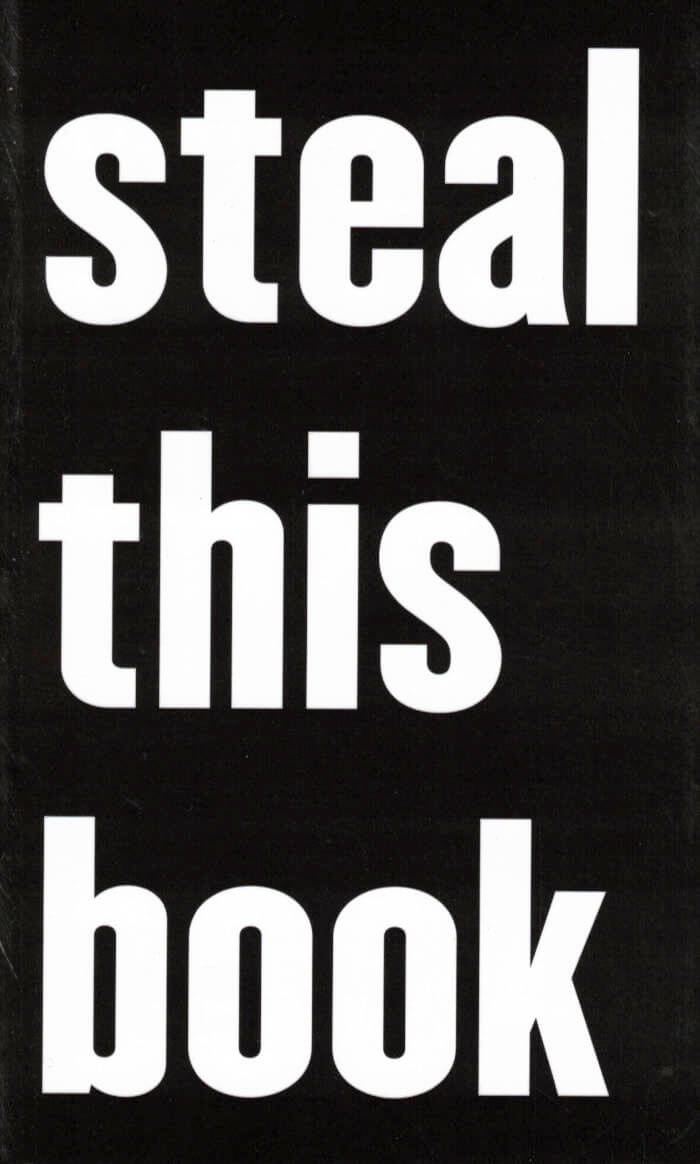
Steal This Book
Eleven performance-based projects by Dora García, documented through letters, emails and other elements from the artist's private correspondence with various interpreters of performances, whether they were direct collaborators of simple spectators.
Edited and prefaced by François Piron, Steal This Book, a tribute to Abbie Hoffmann's pamphlet of the same name, is not a definitive attempt at rendering the pieces on which it is based; it calls for a free, active and contradictory reception, that of an open archive. Part epistolary novel, part rough screenplay and part user's manual, Steal This Book proposes a body of discussions, questions without answers and endless ramblings, in place of the critique's or the artist's voice.
The book has also been presented in exhibitions as a Dora García sculpture meant to be stolen, but it can also be purchased in selected bookstores worldwide.
Contrary to the idea that would have art addressing the greatest possible number of people, Dora García (born in 1965 in Valladolid, lives and works in Barcelona), best known for her performance devices, is interested in what is enacted at the individual scale: in a radically conceptual form, at once accessible and elegant, she elects to transmit oddly coded messages, their ask being to bestir a specific relation with each and every visitor. Dora García is interested in everything that intervenes in the communication between an artist and his/her public: art no longer represents the world, but itself becomes a producer of realities often on the borderline of fiction and make-believe. It urges us to undergo experiences other than ordinary situations, at once simple and hard to grasp.
Dora García has had solo exhibitions at the MACBA in Barcelona, the Reina Sofia in Madrid and the SMAK in Gent. She represented Spain at the Venice Biennale in 2011, and was a part of the Skulptur Projekte Münster 07, the Sydney Biennial in 2009, the Biennale de Lyon in 2009 and Documenta 13 in 2012.

On the Benefits of Friendship
Isabelle Graw reflects on the purposes and struggles of friendship in competitive social milieus.
By focusing on her own social milieu—the art world—Graw demonstrates how friendships are neither totally disinterested nor reduceable to their use. Written in the intimate form of a fictional diary, this book laments useful friendships while praising true friendship in all its forms. For Graw, friendship is an existential necessity—if only because it points to how we relate to and depend on others. Friendship, she finds, is as important as the air we breathe—with it, we are able to fully live.
"On the Benefits of Friendship strangely calls to mind the fictional schoolboy-diary format Robert Walser staged to deliver his first novel. Aware of its own performance while successfully assuming its desired voice, Graw's diaristic story is a clever vehicle for social critique of utility friendships."
— Stephanie LaCava, author of I Fear My Pain Interests You
"Isabelle Graw has written the Elective Affinities for the twenty-first century, as a feminist novel and a dysfunctional family portrait set in the contemporary art world."
— Violaine Huisman, author of The Book of Mother
Isabelle Graw is Professor for Art Theory and Art History at Staatliche Hochschule für Bildende Künste (Städelschule), Frankfurt am Main, where she co-founded the Institute of Art Criticism. She is an art critic and co-founder ofTexte zur Kunst in Berlin.

When the Roots Start Moving – First Mouvement – To Navigate Backward – Resonating with Zapatismo
Chto Delat, Free Home University
To Navigate Backward: Resonating with Zapatismo a book-within-a-book, the first of three mouvements (as in a musical composition) is a collection of essays titled When the Roots Start Moving: Chto Delat and Free Home University—investigating predicaments of rootedness and rootlessness and notions of belonging and of displacement across different geographical and epistemological coordinates.
Zapatismo—the insurgent movement of Indigenous peoples from Mexico—emerges as a form of belonging, a home (or a homecoming) for our hopes and political imaginaries, providing a praxis to learn from and with. The contributors of this book, without romanticizing or objectifying the Zapatista struggle toward Autonomy, offer their understanding of the Zapatistas' movement, of their poetics and politics within an Indigenous cosmovision and cosmopolitics, but also in relation with the current global ecological and social crises.
The book extend the research and practice of artistic collective Chto Delat, long since adopting Zapatismo as a lens to self-reflect and emblematically reminding of how the Zapatista imaginary continues to inspire those who are looking for emancipatory tools: through art, language, radical pedagogy and conviviality, as a practice of commoning and collectively reimagining an otherwise.
To Navigate Backward: Resonating with Zapatismo is a small act of reciprocity—in preparation for the Zapatistas' visit to the European continent, a gesture of solidarity with those who, with fierce care, leave their homes to reverse imposed trajectories, to look in the same direction and share a common horizon.
The conversation hosted in this book by Free Home University will continue in the following two mouvements—Between Displacement and Belonging and Motherlands/Mother Earth.
The collective Chto Delat (What is to be done?) was founded in early 2003 in St. Petersburg by a workgroup of artists, critics, philosophers, and writers from St. Petersburg, Moscow, and Nizhny Novgorod with the goal of merging political theory, art, and activism. Chto Delat sees itself as an artistic cell and also as a community organizer for a variety of cultural activities intent on politicizing "knowledge production". The activity of collective takes responsibility for a postsocialist condition and actualization of forgetten and repressed potentiality of Soviet past and often works as a politics of commemoration. From its inception, the collective has been publishing an English-Russian newspaper focused on the urgent issues of Russian cultural politics, in dialogue with the international context. In 2013, Chto Delat initiated an educational platform—School of Engaged Art in Petersburg and also provides resources for a space called Rosa's House of Culture.
Free Home University exists at the crossroad of engaged art, experimental pedagogy, and political commitment since 2014. Based in Lecce (Italy), FHU has been carrying out artistic investigations and processes of convivial research, engaging with communities of struggle and practice. Artists, farmers, activists, asylum seekers, scholars, thinkers and doers collectively inform learning spaces, through living, studying, and creating together.

Unannounced Voices – Curatorial Practice and Changing Institutions
Alternative forms of curatorial and institutional work suitable to our novel conditions, when the relationship between physical and online work must be revised.
In our current era of global pandemic and violent political upheaval, the question must be asked: What is our future and whose voices will announce it? These can only be situated voices, each with its own body and space, formed through dialogue within their own communities and in reaction and resistance to dominant discourses. Museum director, curator, and writer Zdenka Badovinac argues that these situated voices of people, artworks, and exhibitions, rooted in the local, can bring incisive, productive change. The call of these voices, in rethinking art, curation, and institutions, is the subject of this powerful essay.
Zdenka Badovinac is a curator, writer and director of the Museum of Contemporary Art Zagreb. She served as Director of the Moderna galerija in Ljubljana (1993-2020). In her work, Badovinac highlights the difficult processes of redefining history alongside different avant-garde traditions within contemporary art.

The Black Technical Object – On Machine Learning and the Aspiration of Black Being
A contemplation on the abstruse nature of machine learning, mathematics, and the deep incursion of racial hierarchy.
This book aims to introduce the history of statistical analysis and a knowledge of sociogenesis—a system of racism amenable to scientific explanation—into machine learning research as an act of impairing the racial ordering of the world. While machine learning—computer programming designed for taxonomic patterning—provides useful insight into racism and racist behavior, a gap is present in the relationship between machine learning, the racial history of scientific explanation, and the Black lived experience. Ramon Amaro explores how the history of data and statistical analysis provide a clear (and often sudden) grasp of the complex relationship between race and machine learning. Amaro juxtaposes a practical analysis of machine learning with a theory of Black alienation in order to inspire alternative approaches to contemporary algorithmic practice. In doing so, Amaro offers a continuous contemplation on the abstruse nature of machine learning, mathematics, and the deep incursion of racial hierarchy.
Ramon Amaro is Lecturer in Art and Visual Cultures of the Global South at University College London. His writing, research and practice emerge at the intersections of Black Study, psychopathology, digital culture, and the critique of computation reason.

Wonderflux – A Decade of e-flux Journal
Wonderflux brings together a group of longtime contributors with graphic artists to collaborate on illustrated essays and develop a new pictorial language around some of the emergent consistencies and overarching issues that defined the first decade of e-flux journal.
In Wonderflux you will find yourself in front of disappearing mirrors held up to curators, critics, and artists; sailing through counterfactual universes; face-to-face with cold-blooded killers, faceless men, weary but buoyant prophets; all the while imbued with stubborn thriving and stubborn refusal to be moved or monetized, and once in a while having earnest conversations with robot(s and) workers.
The authors included here have shaped the varied concerns and urgencies of e-flux journal since 2008. As a theory-driven art journal made up entirely of hypertext and digital images and embraced by academic circles, we sometimes wonder about the artistic and sensual use of text and image. Does the thinking of some of our favorite authors also speak to a place beyond floods of automatic links and references and rectangular photographic portals? To a broader and more applied artistic domain like the imaginative sensibility of illustration, where entire worlds arise from the simple and deliberate placement of lines on paper?
Contributions by Franco “Bifo” Berardi, Raqs Media Collective & Freddy Carrasco, Liam Gillick, Elizabeth A. Povinelli & Clara Bessijelle Johansson, Martha Rosler & Josh Neufeld, Reza Negarastani & Keith Tilford, Hu Fang & Mojo Wang, Keller Easterling & Meijia Xu.

Poems: third edition, revised
J.H. Prynne is Britain's leading late Modernist poet. When his Poems was first published in 1999, it was acclaimed as a landmark in modern poetry, and nominated for a New Yorker book prize. It was superseded by the 2005 expanded second edition including four later collections only previously available in limited editions, and that in turn by the 2015 third edition including another six. Poems includes his 1969 collection The White Stones - central to his poetics - which was reissued in 2016 by New York Review Books with an introduction by Peter Gizzi.
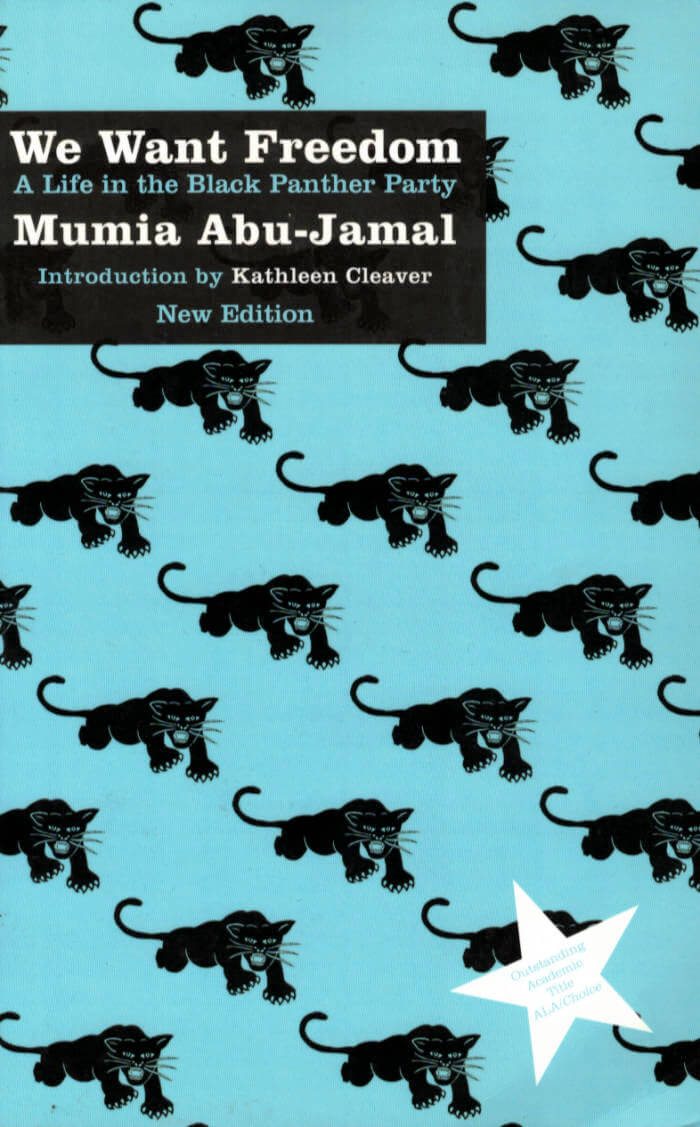
We Want Freedom: A Life in the Black Panther Party
Mumia Abu Jamal, America’s most famous political prisoner, is internationally known for his radio broadcasts and books emerging “Live from Death Row.” In his youth Mumia Abu-Jamal helped found the Philadelphia branch of the Black Panther Party, wrote for the national newspaper, and began his life-long work of exposing the violence of the state as it manifests in entrenched poverty, endemic racism, and unending police brutality. In We Want Freedom, Mumia combines his memories of day-to-day life in the Party with analysis of the history of Black liberation struggles. The result is a vivid and compelling picture of the Black Panther Party and its legacy.
Applying his poetic voice and unsparing critical gaze, Mumia examines one of the most revolutionary and most misrepresented groups in the US. As the calls that Black Lives Matter continue to grow louder, Mumia connects the historic dots in this revised/updated edition, observing that the Panthers had legal observers to monitor the police and demanded the “immediate end to police brutality and the murder of Black people.” By focusing on the men and women who were the Party, as much as on the leadership; by locating the Black Panthers in a struggle centuries old—and in the personal memories of a young man—Mumia Abu-Jamal helps us to understand freedom.